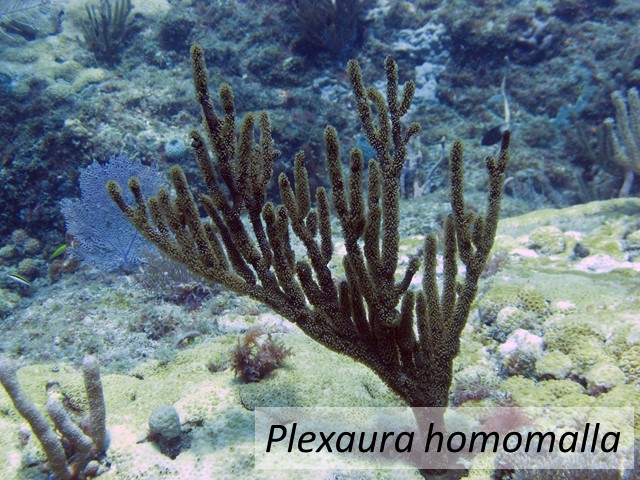
Family: Plexauridae
Common Name(s): Black sea rod
Colony Form: Bushy but in one plane.
Axis: Cylindrical
Branches: Lateral and dichotomous; thin and brittle; to 10 cm long and 2-5-5.0 mm across; crumbly when dried.
Apertures: calices inconspicuously protruding; lip present or not. Aperture round when polyps retracted. Texture smooth with slightly raised bumps.
Mucus: None
Color: Dark brown to black with light brown to yellow polyps. Dries to black or deep brown; purplish brown in alcohol.
Sclerites: Polyp armature: strong, with crown resting on distinct transverse collaret. Axial layer: deep reddish-purple capstans. Middle layer: white or rarely violet spindles to 0.8 mm long. Surface layer: large asymmetrical leaf-clubs with numerous serrate leaves, to ~0.5 mm long.
Habitat: Clear water patch reefs. Deeper-water colonies have more crowded slender branches than taller colonies in more shallow areas. Along the Outer Linear Reef ledge in Broward County, FL.
Distribution: Common in South Florida, the Bahamas and the Caribbean Sea.
Notes: Secondary metabolite production includes fatty acid chain derivatives of a variety of prostaglandins, which are largely biologically inactive, and their purpose in this octocoral remains unknown. Secondary metabolites in other Euniceas may have strong anti-inflammatory, anticarcinogenic and anti-tumor activity. This species produces prostaglandin A2 (PGA) throughout most of the Caribbean at levels 1 million times higher than those of most other organisms. Molecule exhibits the same configuration at carbon 15 as mammalian prostaglandins, except in Florida where P.homomalla synthesizes large amounts of 15(R)-PGA2. Labrids have been observed grazing on the branches of this species. Oral doses of prostaglandins produce vomiting in most species, and this may act as an anti-predator chemical defense against reef fishes.
Similar Species: Eunicea flexuosa









